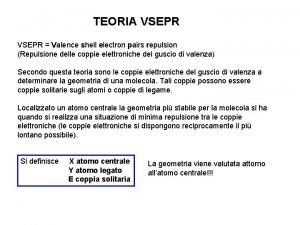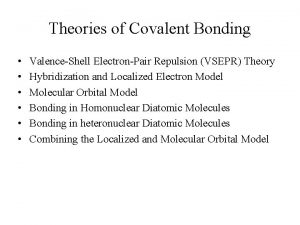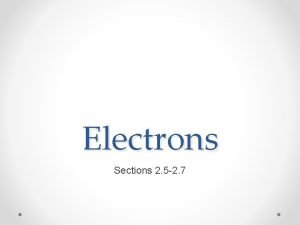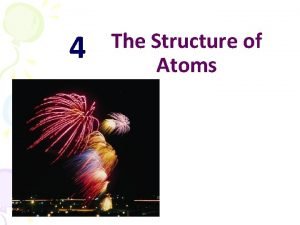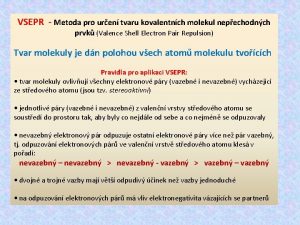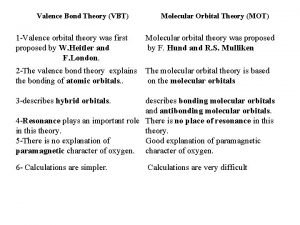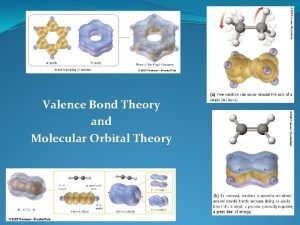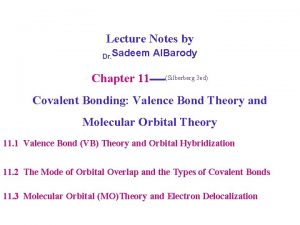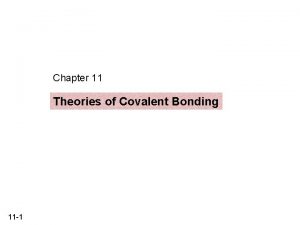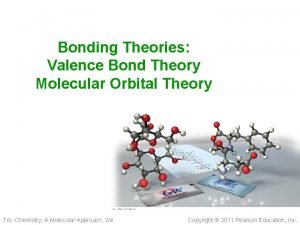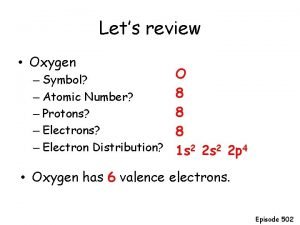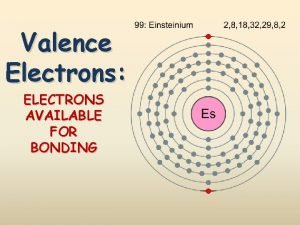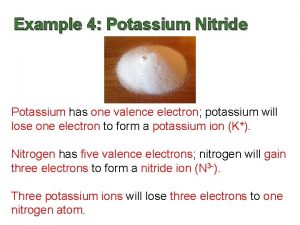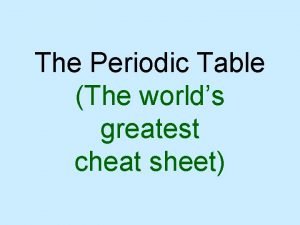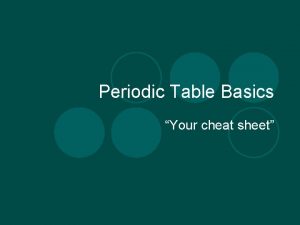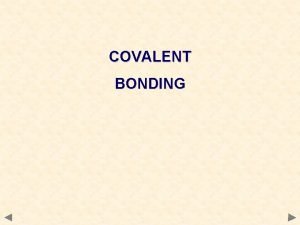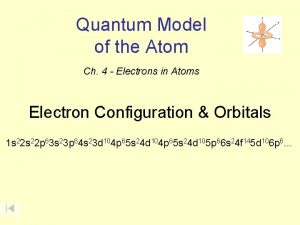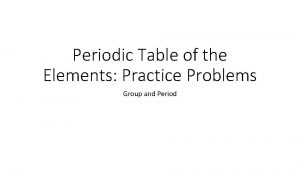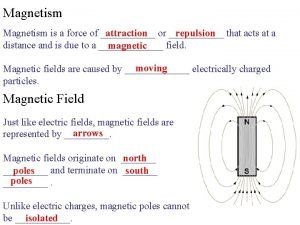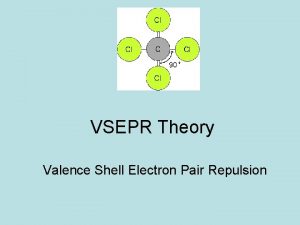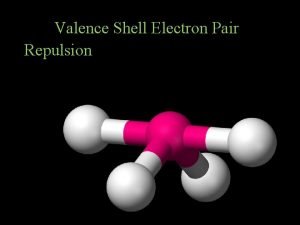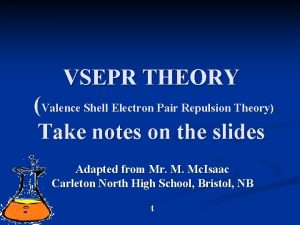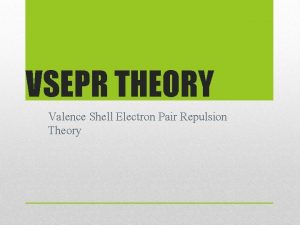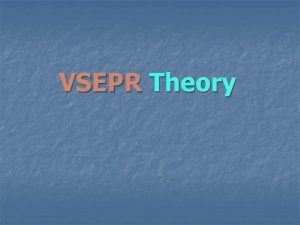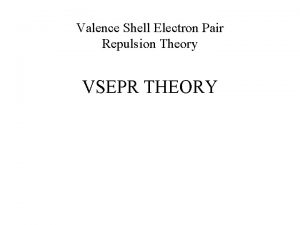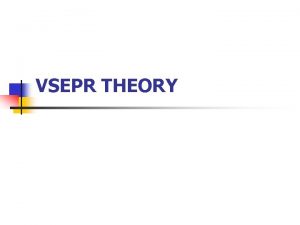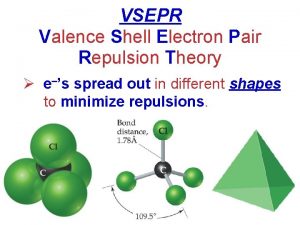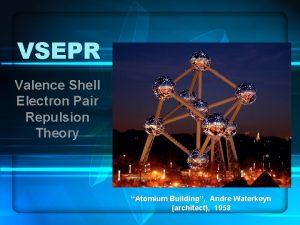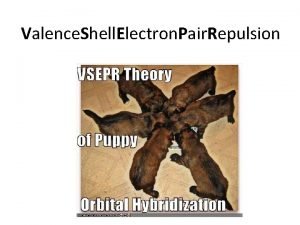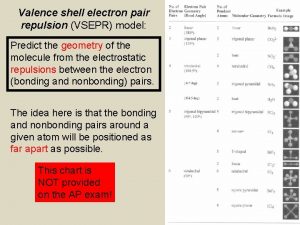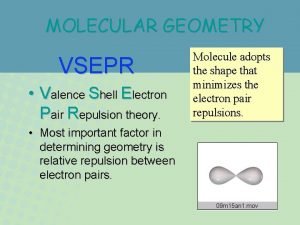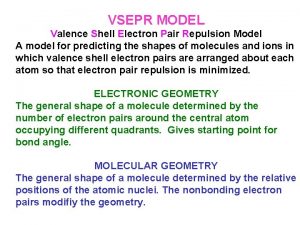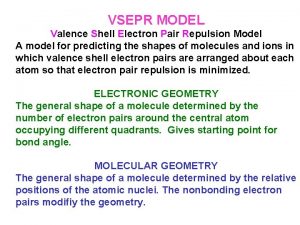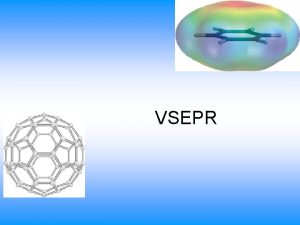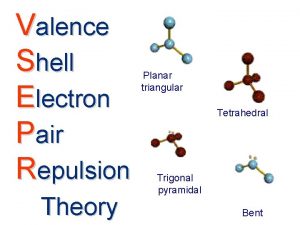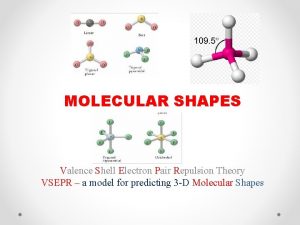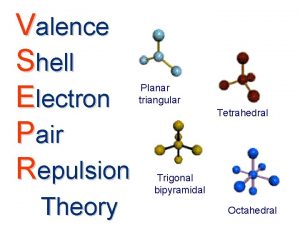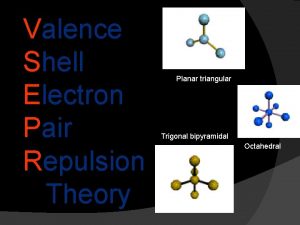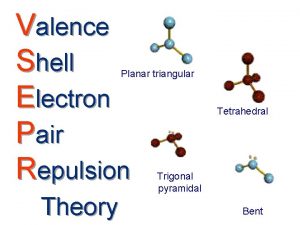1 VSEPR Theory Valence Shell Electron Pair Repulsion





























- Slides: 29

1

VSEPR Theory Valence Shell Electron Pair Repulsion 4 Electrons repel each other in a molecule 4 The structure around a given atom is determined by minimizing electron-pair repulsions (getting pairs of electrons as far apart as possible) – Think about 300 students in the gym, and everyone swinging their arms to make sure they have space on all sides in every direction 4 Helps to predict the 3 -D geometry of molecules 2

Steps for Determining Shape 4 Draw the dot diagram for the compound 4 Most compounds follow the octet rule but not all of them (note: only the central atom can break the octet rule. Boron breaks the rule) 4 Determine how many total pairs of electrons are on the CENTRAL atom 4 Determine how many bonds the central atoms is involved in. (each bond, whether single, double or triple, counts as one shared pair) 4 Look at number of bonds (shared pairs) versus unshared (lone) pairs of electrons and assign shape 3

Linear CO 2 O C O Total Pairs = 4 Shared pairs = 4 Unshared (lone) pairs = 0 *A linear shape occurs any time only 2 atoms bond 4

Trigonal Planar BH 3 H BH H Total Pairs = 3 Shared Pairs = 3 Unshared (lone) Pairs = 0 5

Tetrahedral CH 4 H H CH H Total Pairs = 4 Shared Pairs = 4 Unshared (lone) Pairs = 0 6

Trigonal Pyramidal NH 3 H NH H Total Pairs = 4 Shared pairs = 3 Unshared (lone) pairs = 1 7

Bent H 2 O H Total Pairs = 4 Shared Pairs = 2 Unshared (lone) pairs = 2 8

Bond Angles 4 Bond angles are determined by the number of non-bonding pairs of electrons which push the bonding pairs closer together Linear Trigonal Planar Tetrahedral Trigonal Pyramidal Bent 180° 120° 109. 5° 107. 3° 104. 5° 9

Polar Covalent Bonds

Covalent Bonding A covalent bond is a shared pair of electrons electrostatically attracted to the positive nuclei of two atoms. + - + The atoms achieve a stable outer electron arrangement (a noble gas arrangement) by sharing electrons.

Covalent Bonding Both nuclei try to pull the electrons towards themselves + - + This is like a tug-of-war where both sides are pulling on the same object. It creates a strong bond between the two atoms.

Covalent Bonding Picture a tug-of-war: If both teams pull with the same force the mid-point of the rope will not move.

Pure Covalent Bond H e e H This even sharing of the rope can be compared to a pure covalent bond, where the bonding pair of electrons are held at the mid-point between the nuclei of the bonding atoms.

Polar Covalent Bonding What if it was an uneven tug-of-war? The team on the right are far stronger, so will pull the rope harder and the mid-point of the rope will move to the right.

Polar Covalent Bond A polar covalent bond is a bond formed when the shared pair of electrons in a covalent bond are not shared equally. This is due to different elements having different electronegativities.

Polar Covalent Bond δ- e. g. Hydrogen Iodide δ+ H e e I If hydrogen iodide contained a pure covalent bond, the electrons would be shared equally as shown above. However, iodine has a higher electronegativity and pulls the bonding electrons towards itself (winning the tug-of-war)

Polar Covalent Bond δ- e. g. Hydrogen Iodide δ+ H e e I This makes iodine slightly negative and hydrogen slightly positive. This is known as a dipole.

Polar Covalent Bond In general, the electrons in a covalent bond are not equally shared. e. g. δ+ δ- C Cl 2. 5 3. 0 Electronegativities Polar Bonds (1. 5 minutes) δ- indicates where the bonding electrons are most likely to be found.

Polar and Nonpolar Covalent Bonds Although all covalent bonds involve sharing of electrons, they differ widely in the degree of sharing We divide covalent bonds into nonpolar covalent bonds & polar covalent bonds Bonds are polarized along a continuum from covalent to ionic depending on the difference in electronegativity. A polar covalent bond has some amount of partial + and – charges at either end. A-A δ+A-B δA+ B |______________________________| Covalent Polar Covalent Ionic 20

Polar Covalent Bond Consider the polarities of the following bonds: Difference Electronegativities Bond C Cl 2. 5 3. 0 0. 5 P H 2. 2 0 O H 3. 5 2. 2 1. 3 P H δ+ C δ- Cl Increasing Polarity δ- O H δ+

Polar Vs. Non Polar Properties Polar Covalent Pure (non-polar) Covalent 4 Soluble in water (sugar), 4 Insoluble in water or other polar solutes 4 Think about sugar and water. polar solutes 4 Think about oil and water

Network Solids A compound with all covalent bonds Highest m. p. of all substances Examples: Carbon exhibits the most versatile bonding of all the elements: diamond structure, graphite structure, fullerene structure, nanotubes diamond graphite

Network Solids Diamond structures consists of tetrahedral carbons in a 3 -dimensional array Graphite structures consist of trigonal planar carbons in a 2 -dimensional array. The layers in graphite are able to slide past each other easily. Fullerenes consist of 5 and 6 member carbon rings fused into icosahedral spheres of at least 60 carbons Nanotubes are long hollow tubes constructed of fused C 6 rings

Network Solids Other examples include Silicates: covalent atomic solids of Si and O; includes quartz, pyroxene, asbestos, talc, mica Boron: metalloid almost always found in compounds with O • borax = Na 2[B 4 O 5(OH)4] 8 H 2 O • kernite = Na 2[B 4 O 5(OH)4] 3 H 2 O • colemanite = Ca 2 B 6 O 11 5 H 2 O • Pyrex

Molecular Solids A crystalline molecular solid has molecules arranged in a particular conformation held together by intermolecular forces (van der Waals forces). In water, H 2 O, the molecules are arranged in a regular three-dimensional structure for ice. • Other examples of crystalline molecular solids are table sugar, C 12 H 22 O 11, and sulfur, S 8. Chapter 13 26

Polymers and Proteins Substances composed of molecules characterized by the multiple repetition of one or more species of atoms or groups of atoms covalently linked to each other in amounts sufficient to provide a set of properties that do not vary markedly with the addition of one or a few of the repeating units.

Common Polymers 4 Polymers are common in nature. Wood, rubber, cotton, silk, proteins, enzymes, and cellulose are all examples of polymers 4 A wide variety of synthetic polymers have been produced, largely from petroleum based raw materials. These include polyurethane, teflon, polyethylene, polystyrene, and nylon.

Polymer & Protein Structure 4 Molecular Mass: – High molecular mass structures – Extremely large molecular weights are to be found in polymers/proteins with very long chains. 4 Molecular Shape: – Chain molecules are usually straight chains – These chains may bend, coil and kink, leading to extensive intertwining and entanglement of neighboring chain molecules. – These random coils and molecular entanglements are responsible for many of the important characteristics of such as strength, flexibility and molecular function. – Molecular structure and function are inseparable
 Tetrafluoruro di zolfo
Tetrafluoruro di zolfo Valence shell electron pair repulsion
Valence shell electron pair repulsion C2h4 vsepr
C2h4 vsepr Shell cleanliness shell soundness shell texture shell shape
Shell cleanliness shell soundness shell texture shell shape Shell cleanliness shell soundness shell
Shell cleanliness shell soundness shell How to determine valence electrons
How to determine valence electrons Full valence shell period 3
Full valence shell period 3 Gramatický větný vzorec
Gramatický větný vzorec Valence shell
Valence shell Molecular geometry of pf3
Molecular geometry of pf3 Molecular geometry of pf3
Molecular geometry of pf3 Valence bond vs molecular orbital theory
Valence bond vs molecular orbital theory Valence bond theory vs molecular orbital
Valence bond theory vs molecular orbital Valence bond theory and molecular orbital theory
Valence bond theory and molecular orbital theory 11:55
11:55 Hcn mo diagram
Hcn mo diagram Problem set three episode 502 answer key
Problem set three episode 502 answer key Valence electrons for transition metals
Valence electrons for transition metals Inner electrons of potassium
Inner electrons of potassium What is valence electron
What is valence electron Valence electron cheat sheet
Valence electron cheat sheet Cheat periodic table
Cheat periodic table Carbon valence electrons
Carbon valence electrons Ordered pair and unordered pair
Ordered pair and unordered pair Rolling pair is higher pair
Rolling pair is higher pair Complete outer shell
Complete outer shell My nisd
My nisd How many electron shells does silicon have
How many electron shells does silicon have Repulsion start induction run motor
Repulsion start induction run motor Xxxxbnxxxx
Xxxxbnxxxx
